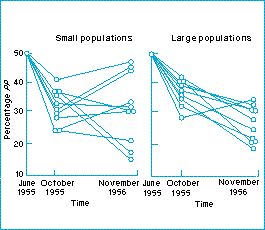Random events in population genetics - What are the effects of random sampling?

Genetic drift
The frequency of alleles with the same fitness will change at random through time in a process called genetic drift. If there are two alleles at a locus, and they have the same fitness, random sampling can cause their relative frequencies in a population to change. These random changes in gene frequencies between generations are called genetic drift, random drift, or (simply) drift. Genetic drift has important consequences for the random substitution of genes and the Hardy-Weinberg equilibrium.
Population size and genetic drift
The rate of change of gene frequency by random drift depends on the size of the population. Random sampling effects are more important in smaller populations. For example Dobzhansky and Pavlovsky, working with the fruitfly Drosophila pseudoobscura, made 10 populations with 4000 initial members (large populations) and 10 with 20 initial members (small populations), and followed the change in frequency of two chromosomal variants for 18 months. The average effect was the same in small and large populations, but as the figure shows, the variability was significantly greater among the small populations.
An analogous result could be obtained by flipping 10 sets of 20, or 4000, coins. On average, there would be 50% heads in both cases, but the chance of flipping 12 heads and eight tails in the small population is higher than the chance of flipping 2400 heads and 1600 tails in the large. If a population is small, it is more likely that a sample will be biased away from the average by any given percentage amount; genetic drift is therefore greater in smaller populations.
This is an important result: the smaller the population, the greater the effects of random sampling. The following Virtual Experiment investigates the relationship between population size and the effects of genetic drift.
Figure: ten large (4000 founders) and ten small (20 founders) populations of the fruitfly Drosophila pseudoobscura were created with the same frequencies (50% each) of two chromosomal inversions, AP and PP. Eighteen months later the populations with small numbers of founders show a greater variety of genotype frequencies. From Dobzhansky (1970).
| Next |



